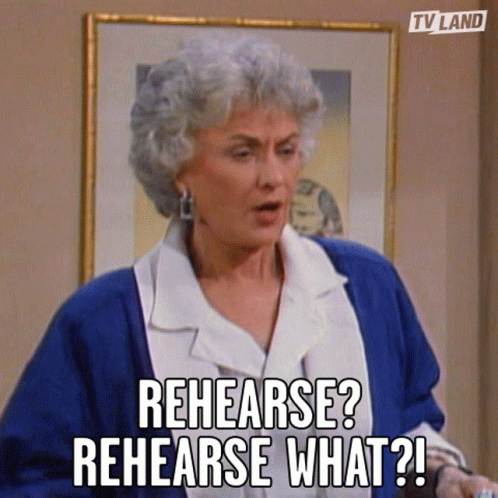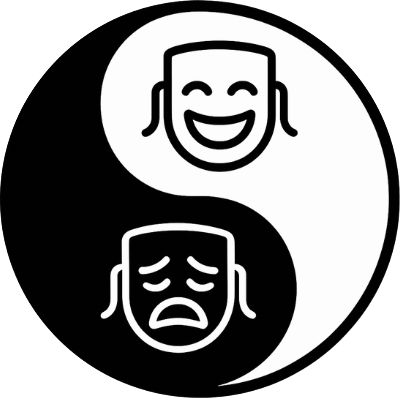The Mental Kind of Rehearsal
Every actor reading this: "Aren't all rehearsals kinda mental?"
The Dojo: "Touché."
However, we aren't here to tell you what you already know (i.e., rehearsal periods are often loco 🙃). Instead, we want to cover what is perhaps the most actor-friendly modality of psychological skills training: mental rehearsal.
The Dojo has been bemoaning the lack of research into psychological skills training with actors since 2019 (and Head Coach T since 2017). But surely there's especially little excuse when the name of the modality contains such an acting-related word. If we were looking for a hint, the clue is right there waving at us.

Yet, we're decades behind sport,[1] dance,[2] and music[3] research. Once again.
sigh
Before we get to the tactical-practical goodness below, we must briefly don our responsible researcher hat to asterisk our most commonly employed asterisk. The Dojo believes in the value of OG psychological skills training, of which mental rehearsal is one.[4] And – OG psychological skills training doesn't seem to be the most effective means of facilitating peak performance.[5] Both of these statements are true.
To be clear, OG psychological skills training can facilitate peak performance – they just seem to be less effective than other means, such as mindfulness- and acceptance-based modalities.[6] [7] But there are other reasons to believe in OG psychological skills training, too, such as their ability to facilitate peak experience (including greater anxiety management, confidence, and sense of self-efficacy[8]). Still, it's a caveat to caveat because we believe informed actors are empowered actors. And y'all know we're all about empowered actors.
Backed by science; built for the stage and screen.
👊 Actors:
Get evidence-informed insights and strategies to support your performance and well-being. Join the Dojo e-newsletter tribe and make thriving your reality.
🧭 Drama schools & Production companies:
Bring pioneering, research-backed coaching into your classroom or rehearsal room. Let's talk about supporting your actors to perform at their peak – and stay well in the process.
The other kind of rehearsal
You may have heard mental rehearsal go by other names, such as imagery or visualisation. We like the "mental rehearsal" branding because the "rehearsal" bit is so actor-friendly and better represents the skill's multi-sensory nature, too.
Current literature defines mental rehearsal as "a multimodal cognitive simulation process that allows for the representation of perceptual information in the mind without actual sensory input".[9] However, we can think of it more simply as doing in our mind what we do during actual rehearsal time: engaging all our senses to practice performance. One handy perk of mental rehearsal, of course, is that we can do it whenever and wherever – we don't need the physical stage or set, nor full cast or crew.[10]
Circling back to the paragraph above, meta-analyses find that mental rehearsal has a "small but significant positive effect on performance".[11] [12] And the Dojo, for one, isn't above gaining a "small but significant" gain.
Rehearsing the other way
More specifically, there are two distinct "small but significant" gains to be gained, which serendipitously align with our distinct actor / acting selves.
First, mental rehearsal can help us regulate anxiety and increase confidence.[13] Useful to our actor self. Second, mental rehearsal can help with mistake correction and skill mastery.[14] [15] Useful to our acting self.
As for the nitty-gritty? Research offers a few key recommendations:
- These are short "rehearsals". The sweet spot seems to be around 20 minutes per session.[16]
- However, they need to be hit regularly and consistently. Think three times per week for at least six weeks.[17] [18]
- Combine with related psychological skills training, such as self-talk and film room for compounded effects.[19]
With these considerations in mind, we can then walk through the tried-and-true PETTLEP model.[20]
- Physical: Sit during mental rehearsal if you're sitting in performance. Stand if standing. Even if your eyes are closed or your gaze lowered, you can mark movements or gestures.
- Environment: Mentally rehearse "in" the space you'll be performing in. Taking / sourcing photos or videos of the venue or set can be a huge help here.
- Task: Focus on short, specific segments to mentally rehearse, one at a time. In the actor context, perhaps that means rehearsing confidence as you stand in the wings. In the acting context, maybe this looks like rehearsing a scene's complex blocking to be filmed in one take.
- Timing: Approximate real-life timings. If you have 10 minutes in the wings before curtain up, take about 10 minutes for each mental rehearsal rep.
- Learning: Match the content to your current level of mastery. No need to render every inch perfectly on day one. Start with the bare-bone essentials, then build up from there.
- Emotion: Allow emotions to arise as they would during performance. To paraphrase the creators of the PETTLEP model, acting isn't a "hyper-relaxed state", so why should mental rehearsal be anything otherwise?[21]
- Perspective: Align your perspective (i.e., first-person or third-person) with the context and desired outcome of each mental rehearsal rep.

Perhaps the idea of more rehearsal strikes you as highly unappealing. That's fair. Regular rehearsals alone can be a lot. Still, it could be worth keeping the mental kind of rehearsal in the toolkit. You never know when you'll next be hungry for a 1% gain.
Love what you're reading? Help us keep it flowing. Donations support the research, writing, and free sharing of evidence-informed tools for actor performance and well-being. Every dollar fuels our mission to make thriving a reality for actors everywhere 🔥
Citations
[1] https://doi.org/10.1037/0021-9010.79.4.481
[2] https://doi.org/10.1016/j.tsc.2020.100739
[3] https://doi.org/10.1186/s13612-014-0018-3
[4] https://amzn.to/3HjGGfx (p. 11)
[5] [7] https://doi.org/10.1007/s12671-019-01098-7
[6] https://doi.org/10.1123/jcsp.3.4.320
[8] [13] https://doi.org/10.1080/10413200.2011.574676
[9] [12] [17] [19] https://doi.org/10.3390/bs15050685
[10] [11] [16] [18] https://doi.org/10.1016/j.psychsport.2020.101672
[14] https://www.scapps.org/jems/index.php/1/article/view/3492
[15] https://doi.org/10.1152/jn.00257.2010
[20] [21] https://doi.org/10.1080/10413200109339004
Cite us!
IG: @theactorsdojo
APA 7: Norrish, T. (2025, June 18). The mental kind of rehearsal. The Actor’s Dojo. https://www.dojoactors.com/mental-rehearsal/
